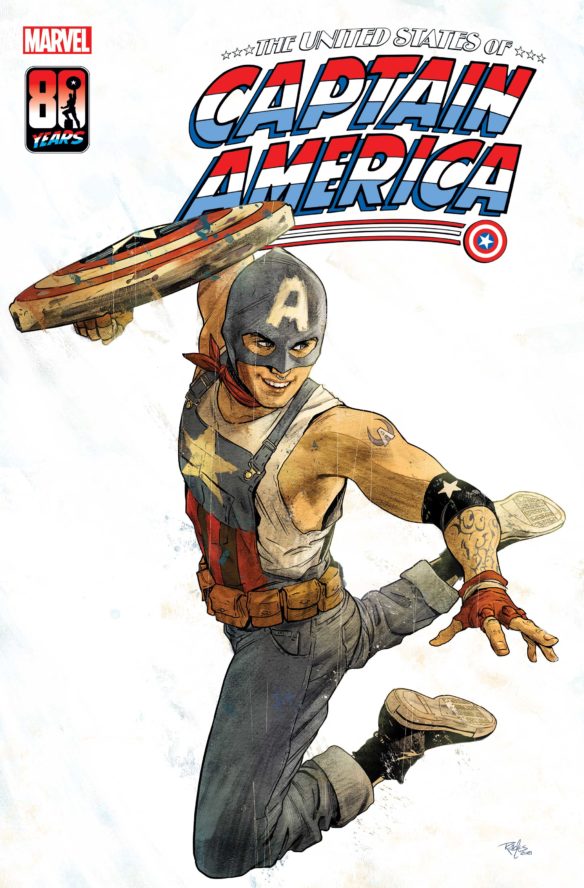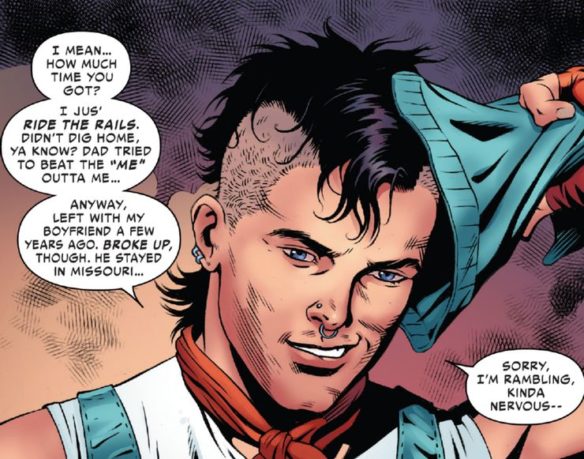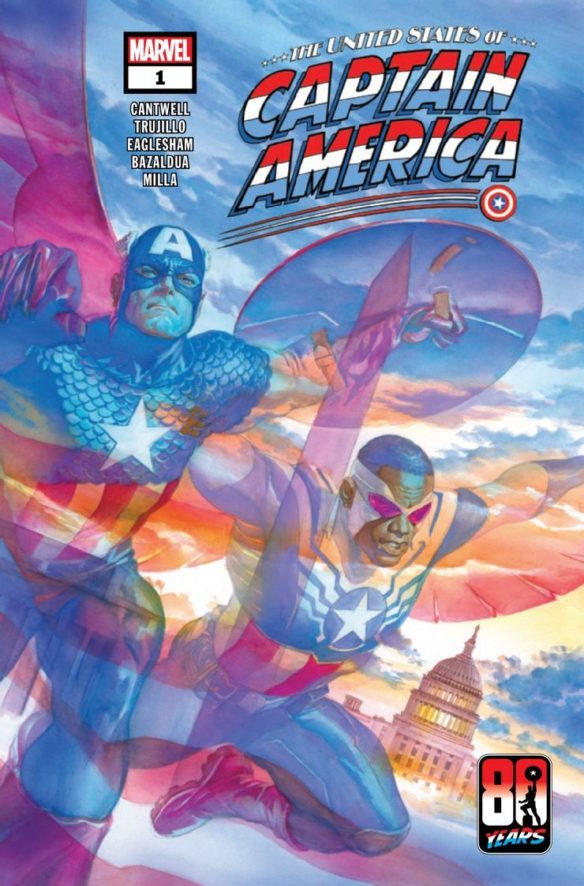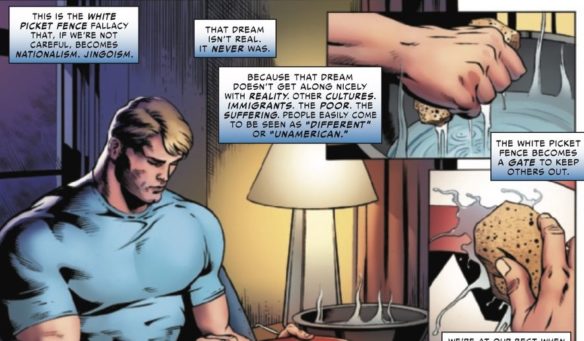
By James Bacon: Welcome Aaron Fischer, Captain America of the railways.
Captain America, a symbol of what is right, standing for justice, the pinnacle of heroism, punching Hitler from the outset, has always asked difficult questions, has eschewed purely jingoistic nationalism, has told stories that questioned what it means to be Captain America and whether America is right, and what is morally the right thing to do.
Over the 8 decades of the character’s existence, in thousands of comics, frequently we have seen this reflection and challenge in the character, questioning much. In Captain America #180 (Dec 1974) Steve Rogers, disgusted with the US government and a senior official who is supporting terrorism, assumed and hinted to be Richard Nixon and mirroring Watergate, can no longer wear the red, white and blue uniform and starts fighting as Nomad, a person with no country. Fifteen years later, the government again appalls Steve Rogers and by issue #332 (Aug 1987) in he takes on the mantle of “The Captain” and John Walker who was the Super Patriot takes on the mantle of Captain America. It’s a useful story turn.
Here, in this issue straight away, Steve Rogers questions what the American Dream is but in a way that suddenly spoke strongly to me. As I look across the Atlantic into America, it’s odd contemplating freedom, or considering what it doesn’t mean to me or mean to others in America, be it being able to own an assault rifle, eat what you want, have black smoke emanate from your car, pay as little taxes as you can while working in a brutal oppressive capitalist profit driven stitch-up where workers rights are minimal, weakness is scorned and belittled, and where there is no social responsibility, and those less fortunate face destitution or death, with the wealthy subsidized, supported and untaxed. I don’t think that is freedom at all, just subtle ensnarement to a mis-sold system where the rich get richer and people are allowed to imagine the American Dream. It’s a fecking nightmare, with workers pitted against other workers, instead of solidarity against billionaires who buy off their guilt with charity, Americans fooled into thinking they pay less in taxes than others, but instead pay huge amounts of health insurance, where climate change is leading to power outages, where water the simplest of things, may poison them….
Science fiction readers, intelligent and thoughtful get this, understand and can see injustice and duplicity, the society slowly walking into a tyranny would be obvious.
It didn’t seem like this on Telly. You know, I don’t recall the Murder She Wrote where the lack of insurance was the cause of death, or the episode where Joey dies from septicaemia while in between jobs, or the ER team writing down these vital insurance details, and so, as one learns more about America, quite a wonderful place, parts slightly tarnished, it gets very ropey, sketchy, not what one had imagined at all. And I love the place. I really do.
So back to Cap who is thinking about the Dream. “I’m Loyal to nothing, except the dream” “I actually said that once”… “But lately– spending my days in this country, as the years march on by — I’m starting to think America actually has two dreams and one lie.” He describes one dream as something that never really existed, which can become nationalistic and jingoistic, using a white picket fence as an analogy, because that dream doesn’t get along nicely with reality, other cultures, immigrants, the poor and the suffering. People easily become seen as “different” or “un-American.” He describes the lie, the empty promise, “instead of a dream they get a raw deal.” He describes it as a lie.
He continues to muse about the dream, one where people work and fight together, but his uncertainty and doubt about things comes through thinking; “The Smithsonian is putting on a special exhibit called ‘Americans who Fight’ To tell you the truth, I don’t really love the name, only because so sometimes we fight when I feel like we could handle things another way.”
We get seven pages of good reflection and introspection, suddenly broken by someone in a Captain America costume, breaking in and stealing the Shield. As a chase ensues, Steve is currently wearing the Steve Rogers super soldier costume, no red and white midriff, and he enlists the Falcon to help him chase down the thief, and things come to a head on Hell Gate bridge where the impostor derails a train using the shield, leaving Steve Rogers and the Falcon to first avert disaster and then help with those who have been injured in a serious train crash.
As the rescue continues Cap grabs hold of someone dressed like Captain America, and we meet Aaron Fischer, who explains that the people on the rails are kinda like family, and unsavory people show up, he deals with them, fighting for those who need it. Fischer is absolutely in awe of his heroes, and Falcon leads the way in keeping things very cordial, and Fischer explains that there are more “Captains”, a sniper tries to take out Aaron and Cap saves him, and both he and the Falcon affirm that Aaron is a Captain America. Despite this, after getting his wound taken care of, he disappears, but Steve and Sam agree to go find the shield, with Sam putting on the Captain America uniform and also warn the other Captains America of the danger of the assassin. It’s a nice easy intro to a road trip story. Christopher Cantwell did a good job, I liked the questioning side. Sale Eaglesham’s art is really nice in places, although I thought that the physique of both Steve and Sam were a little too exaggerated, but it was good overall.

Then we get “Tracks”, a second story by Josh Trujillo and Jan Bazaldua. This tells the story of Aaron Fischer, an admirer of Captain America, an “A” tattooed on one arm, he hears that unhoused kids are being disappeared. Roxxon are kidnapping them and using them as a form of labor, and so Aaron, takes it upon himself to daub his denim dungarees with the appropriate colors, make a shield, don a mask and fight, and so he does, and with a young sweetheart in tow. It’s a nice story, and we get to meet someone who is coming from a different background.
Josh Trujillo and artist Jan Bazaldua spoke to Out (“How the Gay Captain America Creators Crafted Aaron Fischer’s Look”) about the character: “The overalls were something Jan Bazaldua and I settled on really quickly. They felt true to the character and were more practical than a super suit. Plus, I just think the overalls look cool.” said Trujillo. “We tried to give him a simple appearance since he is a street boy who lives in LA, someone who could only make his suit with what he had on hand,” Bazaldua added. “And we just tried to give him a kind look, someone who did not have resources or large amounts of money but has a huge heart and a great desire to help people like him.” Bazaldua also said the two of them were excited to take “a very American and very macho symbol,” and make him gay and someone who resonated with real-life queer people, and that includes sharing in their struggles. The issue of young LGBT homelessness being one they wanted to draw attention to.

“Aaron is inspired by heroes of the queer community: activists, leaders, and everyday folks pushing for a better life,” Trujillo said in a release. “He stands for the oppressed, and the forgotten. I hope his debut story resonates with readers, and helps inspire the next generation of heroes.” Bazaldua said. “I really enjoyed designing him, and as a transgender person, I am happy to be able to present an openly gay person who admires Captain America and fights against evil to help those who are almost invisible to society” and added, “While I was drawing him, I thought, well, Cap fights against super-powerful beings and saves the world almost always, but Aaron helps those who walk alone in the street with problems that they face every day. I hope people like the end result!”
And I think they have done a wonderful job. I have to say that the artwork was super, really clean lines, with some lovely perspectives, low down giving one a sense of not just street level, but being on the street, and the action was also smartly done, with a great sense of movement. The tender moments are perfectly timed, while the story was really advanced by the slick and smooth artwork.
And so one would recommend the comic….
And then well, Washington Times and Fox News happened.
The Times headline was “Marvel celebrates July 4 weekend by having Captain America say American dream ‘isn’t real’”, on the 2nd of July, and yeah, quotes Captain America.

They then, dreadfully, excise Aaron Fischer from the story, but use his lines saying “Another point in the story features a character who, standing next to Captain America, suggests that Sam Wilson, a Black character, is more representative of all Americans. ‘Wow, Sam Wilson,’ the character says. ‘Two Captain Americas for the price of one. Can’t tell you how much it means to meet both of you. You fight for everyone. I mean … everyone.’”
Well, Sam Wilson is representative. And I thought Aaron’s words were nice here. Give Sam some love, why not, he is a great character. But for some, it is reason for umbrage.
Then Fox News obviously picked up on the “news” and they rolled out some opinions. Senator Tom Cotton, wanted Captain America cancelled, or at least demoted to Lieutenant. (WtF)
Then on the 5th of July, Dean Cain, like talk about Hero to Zero, I know he once played Superman, now obviously a poor pundit for Fox and Friends, went on to criticize the comic and rage against wokism….
“I am so tired of this wokeness and anti-Americanism,” Cain said, while later admitting that he actually hadn’t read the comic…
And getting some mileage, comedian Michael Loftus was angry. He reckoned Marvel and Stan Lee are the embodiment of the American dream and this story violated that.
I had a little laugh there, to be honest. Stan was no angel, but he came up with some brilliance, but he often spoke positively and encouraged people to be really good, but I reckon he would have loved the publicity.
I think this all mis-portrays what is going on of course, Captain America is meant to question America and this has occurred many times over the years.
The idea of the dream is interesting, I was impressed that Ta-Nehisi Coates focused on the dream as his departure point and then Captain America here starts with questioning the dream and I loved that connectivity.
The loyalty to the Dream may be a reference to Daredevil #233 at the end of Frank Miller’s run with artist David Mazzucchelli in an arc featuring Nuke, where Cap states that “I’m Loyal to nothing General.. except the dream” as he holds the flag. This portrayal is one where Daredevil educates Cap, who seems mildly naïve, but does do the right thing.
Yet Captain America has never been a flag-clutching propaganda tool. Well in Marvel Fanfare 19, with art by Frank Miller, written Roger Stern and Roger McKenzie Cap is it is a bit overly sickly sycophantic, but…
Created at the end of 1940, a year before America had entered the Second World War, Joe Simon and Jack Kirby, two working class Jewish New Yorkers, the sons of immigrants portrayed Captain America punching Hitler.
Joe Simon who came up with Captain America said of the germination of the character, “’We both read the newspapers, we knew what was going on over in Europe. World events gave us the perfect comic-book villain, Adolf Hitler, with his ranting, goose-stepping and ridiculous moustache. So we decided to create the perfect hero who would be his foil. I did that first sketch of Captain America, and Jack and I did the entire first issue before showing it to (publisher) Martin Goodman at Timely Comics. He loved it immediately.’ he continued ‘But when Captain America came out, America wasn’t yet in the war, so the American Nazis weren’t happy with what we did to their beloved Fuhrer. … We had a couple of personal encounters with the Bund (German American Bund, a US Nazi group 25,000 members). But that didn’t stop us. If anything, it added fuel to the fire.’”
This was serious stuff. In the Comic Book Makers Simon says that “Our irreverent treatment of their Fuhrer infuriated them. We were inundated with a torrent of raging hate mail and vicious obscene telephone calls. The theme was ‘Death to Jews”… “but then, people in the office reported seeing menacing-looking groups of strange men in front of the building at 42nd St… we reported the threats to the police department.”
One day Joe Simon was told there was a call, being told “There’s a man on the phone says he’s Mayor LaGuardia and he wants to speak to the editor of Captain America” and the Mayor personally called to guarantee that no harm would come to the Captain America creators, with Simon quoting him as saying “You boys are doing a good job, The City of New York will see that no harm will come to you.” (“Art Spiegelman: golden age superheroes were shaped by the rise of fascism” in The Guardian.)
The cover was hugely political, and while the stories were in parts fantastical, it put a clear enemy at the forefront, and a hero to take it on. Joe Simon and Jack Kirby went on to serve their country in the Second World War and Captain America has remained, for eighty years.
Politics has been deftly avoided at times. Tales of Suspense #61 from January 1965 saw Captain America travelling to Vietnam to seek out a captured pilot, who is a POW and brother of a WWII veteran who helped Cap.
Cap has to fight a Sumo fighter, who is the champion of a Vietnam General, and then he and Barker escape and in doing so effectively run away from the challenging politics that surrounded the American War in Vietnam for over five years.
Issue 125 of Captain America May 1970, written by Stan Lee with art by Gene Colan, we saw Cap distraught after breaking up with Sharon Carter, and so again we go to Vietnam, he needs something to do….
Cap seeks the kidnapped Dr. Robert Hoskins. Parachuting out of a B-52 he gets captured, and is taken to the Mandarins Castle — Iron Man’s foe. Although he defeats the Mandarin and escapes with Hoskins and this helps all involved get back to peace talks, the final panel, is full of woe but the last line where he says “and the knowledge that one day, even Captain America must surely face defeat” really felt like a subtle commentary on Vietnam.
Though one would love to say that Disney, Marvel are wonderful and perfect, they surely are not, and issues about recognition and payment are well known. Ta-Nehesi Coates spoke out about this recently, and one of the most senior Marvel Execs, Ike Perlmutter supported and worked for Donald Trump (“Meet Reclusive Marvel Billionaire Ike Perlmutter, Trump’s Close Friend” at Business Insider.) And there was much unhappiness amongst fans when Captain America shields or t-Shirts were misappropriated by fascist and racists at right wing protests. Indeed Neal Kirby, son of Jack, said when he saw images of the Storming of the Capital Building (“Captain America creator’s son hits out at Capitol mob’s use of superhero imagery” in The Guardian) — “Captain America has stood as a symbol and protector of our democracy and the rule of law for the past 79 years. He was created by two Jewish guys from New York who hated Nazis and hated bullies. Captain America stood up for the underdog and, as the story was written, even before he gained his strength and process from Army scientists, always stood for what was righteous, and never backed down.” “I was appalled and mortified. These images are disgusting and disgraceful. Captain America is the absolute antithesis of Donald Trump. Where Captain America is selfless, Trump is self-serving. Where Captain America fights for our country and democracy, Trump fights for personal power and autocracy. Where Captain America stands with the common man, Trump stands with the powerful and privileged. Where Captain America is courageous, Trump is a coward. Captain America and Trump couldn’t be more different.”
I hope that we get to see more of Aaron Fischer, and the other Captains America, as Sam and Steve go on their journey and I look forward to Aaron’s adventures, and those of future Captains America, Nichelle Wright, the Captain America of Harrisburg, Joe Gomez, the Kickapoo Tribe’s own Captain America, Ari Agbayani a college campus based Captain America and Air Force Captain Jeremy Merrick who looks out for veterans who have fallen through the tracks, as this five-issue mini-series develops.
Discover more from File 770
Subscribe to get the latest posts to your email.



I shall have to look it up. I was a bit meh about the idea of a whole army of Captains America, but you’ve sold me
Minor typo “Sale Eaglesham’s art” should be Dale.
Steve Rogers was Cap when I was growing up; he’ll always be my Cap, but heck yes! Cap has always stood, as this article says, for the underdog. And if it takes 3, 4, 5 or ten Caps to make sure all underdogs are protected and cared for, why not?
“The loyalty to the Dream may be a reference to Daredevil #233”
Belated comment that it may be this, but it may also be a reference to Ta-Nehisi Coates’ Between the World and Me which talks extensively about the Dream and Dreamers.
It’s nice that references needn’t refer to just one thing.
Pingback: Pixel Scroll 1/18/22 21 Jaunt Street | File 770